The Steam Turbine
by Sir CHARLES A. PARSONS, K.C.B.
Before passing to the consideration of other applications of the
turbine I should like, with your permission, to repeat an experiment which
illustrates the phenomenon of cavitation. The chief difficulty in applying
the turbine to marine propulsion arose in the breaking away of the water, or
the hollowing out of vacuous cavities when it was attempted to rotate the
screw above certain limits. The phenomenon was first observed by Sir John
Thornycroft and Mr Sydney Barnaby. They designated this phenomenon by the
appropriate name "Cavitation," and it entails, by



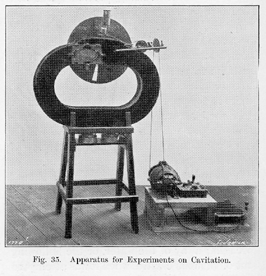
the way, a great loss of power. The remedy lies in using very wide blades
covering about two-thirds of the disc area of the propeller, so as to present a very large
bearing surface on the water, and this expedient effectually prevents its
giving way under the force necessary to propel the vessel.
In models, and in vessels of moderate speed, the forces are not sufficient to tear
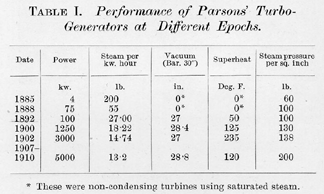
the water asunder, but if the pressure of the atmosphere is removed by an air pump, a model screw will cavitate at a comparatively moderate speed.
The improvement in efficiency resulting from the successive modifications and improvements in the proportions of turbines, and also arising from the increase in the size is shown by the particulars given in the Table opposite.
Table II on this page gives corresponding data in regard to marine turbines.
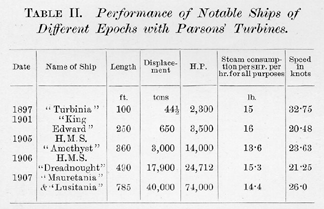
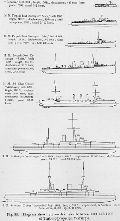
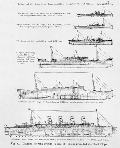
Many warships are now being fitted with installations with double and treble turbines in series on the steam and exceeding the
power developed by the "Mauretania" and "Lusitania." The aggregate power of Parsons' turbines fitted for marine propulsion up to date is six million shaft horse-power. This embraces ships of proctically all nationalities. The power of turbines of the same type made for generating electricity and other duty on land is also about six million shaft horse-power--considerabley more than the available power of Niagara Falls. The diagrams on the four preceding pages indicate the size of ships fitted at different successive periods for the Royal Navy and for the merchant marine.
The marine turbine, with the modifications we have so far described, is only suitable for vessels of over 16 knots speed, and to extend its use to vessels of a less speed than this, which comprise two-thirds of the tonnage of the world, has been our constant aim. The first plan for the attainment of this end is somewhat in the nature of a compromise, and is called the combination system, because the reciprocating engine is used to take the first part of the expansion and the turbine the last. From what we have said it will be apparent that this coalition of the reciprocating engine and turbine is a good one, because each works under favourable conditions. The reciprocating engine expands
the steam to about atmospheric pressure, and the turbine carries on the expansion with high efficiency down to the pressure in the condenser. Now, though a large and high speed turbine can be made to deal with the high pressure portion of the expansion
as economically as a reciprocating engine, a slow speed turbine cannot be made to do so, but on the other hand a slow speed turbine expands low pressure steam much further and more economically than any reciprocating engine. Under this system the turbine generally is made to develop about one-third of the whole power.
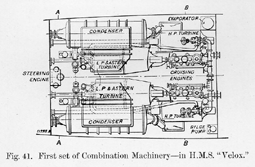
About 15 years ago this plan was worked out and the British Admiralty destroyer "Velox" was so fitted in 1902 (page 43), but no further practical steps were taken torwards its application until about three years ago.
Messrs Denny of Dumbarton, who in 1901 built the first mercantile turbine vessel, the "King Edward," in 1908 built the first combination vessel, the "Otaki" of 9,900 tons and 13 knots speed. She has ordinary twin screws driven by triple expansion engines which exhaust into a turbine driving a central screw as illustrated on the next page. The initial pressure at the turbine is 9 lbs. absolute, and it develops one-third of the whole power. This combination vessel was
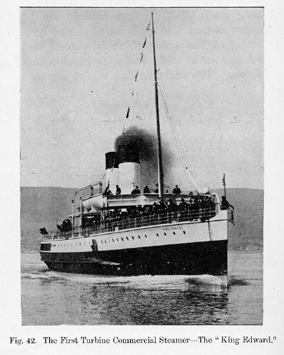 found to consume 12 per cent less coal than her sister vessel on the same service,--the "Orari," fitted with quadruple reciprocating engines. The next combination vessel was the "Laurentic" of 20,000 tons built by Messrs Harland and Wolff, a sister vessel to the "Megantic," fitted with quadruple engines, and on service at the same speed the saving in coal by the combination is 14 per cent.
The combination system has also been adopted in the White Star liners "Olympic" and "Titanic" of 60,000 tons displacement, as well as in some other vessels at home and abroad.
found to consume 12 per cent less coal than her sister vessel on the same service,--the "Orari," fitted with quadruple reciprocating engines. The next combination vessel was the "Laurentic" of 20,000 tons built by Messrs Harland and Wolff, a sister vessel to the "Megantic," fitted with quadruple engines, and on service at the same speed the saving in coal by the combination is 14 per cent.
The combination system has also been adopted in the White Star liners "Olympic" and "Titanic" of 60,000 tons displacement, as well as in some other vessels at home and abroad.
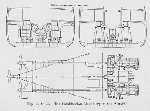
There is another promising solution of the problem for applying the turbine to slower vessels, which will extend its field still further over that of the reciprocating engine. I mentioned before that de Laval had in the 'eighties introduced helical tooth gear for reducing the speed of his little turbines. For 23 years it has worked admirably on a small scale. Recent experiments, however, have led to the assurance of equal success on a large scale for the transmission of large powers.
Preliminary experiments were made some years ago on helical reduction gear, which showed a mechanical efficiency of over 98%, and a 22 feet launch was constructed in 1897: the working speed of the turbine was 20,000 revolutions per minute, which was geared in one reduction of 14 to 1 to the twin screws. The speed attained was 9 miles per hour, and this little boat was many years in use as a yacht's gig. She was the first geared turbine vessel. The next step was to test geared turbines in a typical carge boat, and the "Vespasian" was purchased in 1908. She is of 4,350 tons displacement, and was propelled by a good triple expansion engine of 900 horse-power. After thoroughly overhauling and 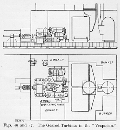 testing her existing machinery for coal and water consumption, to make sure that it was in thorough good order, the engine was taken out and replaced by geared turbines, the propeller, shafting, and
boilers remaining the same. On again testing for economy with the new machinery a gain of 15 per cent was shown over the reciprocating engine, and a subsequent alteration
to the propeller has increased this gain to 22 per cent, a very remarkable saving. The new machinery, which is much lighter than the old, consists of a high pressure and a low pressure turbine, each driving a pinion at 1,400 revolutions, gearing into a spur wheel on the screw making 70 revolutions per minute (page 52). The gearing is entirely enclosed in a casing, and is continually sprayed with oil by a pump.
It is interesting to compare the working of the new and the old machinery. The appended diagram (Fig. 48) shows the comparative water consumption with reciprocation and turbine engines. Everyone who has experienced a rough sea in a screw vessel knows the disagreeable sensation of the racing of the engines whenever the screw comes out of the water. In the turbine vessel nother of the kind occurs, and the reason is very simple. It is because of the great angular momentum of the turbines, which is about 50 times that of ordinary engines, consequently they gather speed so slowly
testing her existing machinery for coal and water consumption, to make sure that it was in thorough good order, the engine was taken out and replaced by geared turbines, the propeller, shafting, and
boilers remaining the same. On again testing for economy with the new machinery a gain of 15 per cent was shown over the reciprocating engine, and a subsequent alteration
to the propeller has increased this gain to 22 per cent, a very remarkable saving. The new machinery, which is much lighter than the old, consists of a high pressure and a low pressure turbine, each driving a pinion at 1,400 revolutions, gearing into a spur wheel on the screw making 70 revolutions per minute (page 52). The gearing is entirely enclosed in a casing, and is continually sprayed with oil by a pump.
It is interesting to compare the working of the new and the old machinery. The appended diagram (Fig. 48) shows the comparative water consumption with reciprocation and turbine engines. Everyone who has experienced a rough sea in a screw vessel knows the disagreeable sensation of the racing of the engines whenever the screw comes out of the water. In the turbine vessel nother of the kind occurs, and the reason is very simple. It is because of the great angular momentum of the turbines, which is about 50 times that of ordinary engines, consequently they gather speed so slowly 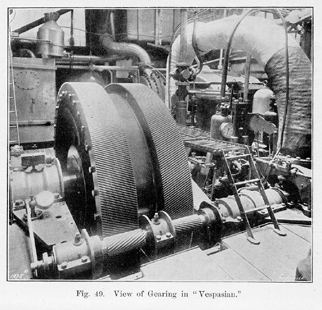 that before they have appreciably accelerated the screw is down again in the water. Ordinary engines often accelerate up to three times their ordinary speed in a heavy sea, and what shakes the ship and breaks
that before they have appreciably accelerated the screw is down again in the water. Ordinary engines often accelerate up to three times their ordinary speed in a heavy sea, and what shakes the ship and breaks
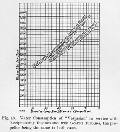 the screw shafts is the shock on the plunging of the madly whirling propeller into the sea.
The "Vespasian" has now covered 20,000
miles in all weathers and carried 90,000 tons of coal from Newcastle to Rotterdam.
The pinion on the table was removed from the vessel a month ago for the purpose of showing it at this lecture. As you can see it shows no sign of wear. The gearing is illustrated on page 52.
Gearing promises to play a very important part in war vessels for increasing the economy at reduced speeds. I explained the difficulty in obtaining good economy under such conditions, and by means of geared high speed turbines the efficiency will be greatly increased. The Turbinia Company are now constructing two 30-knot destroyers of 15,000 horse-power with this arrangement (page 54). The high pressure portion and cruising elements are geared in the ratios of 3 to 1 and 5 to 1 respectively to the main low pressure direct coupled turbine, and their use will increase the effective radius of action at cruising speed by nearly 50 per cent over that of a similar destroyer without gearing.
the screw shafts is the shock on the plunging of the madly whirling propeller into the sea.
The "Vespasian" has now covered 20,000
miles in all weathers and carried 90,000 tons of coal from Newcastle to Rotterdam.
The pinion on the table was removed from the vessel a month ago for the purpose of showing it at this lecture. As you can see it shows no sign of wear. The gearing is illustrated on page 52.
Gearing promises to play a very important part in war vessels for increasing the economy at reduced speeds. I explained the difficulty in obtaining good economy under such conditions, and by means of geared high speed turbines the efficiency will be greatly increased. The Turbinia Company are now constructing two 30-knot destroyers of 15,000 horse-power with this arrangement (page 54). The high pressure portion and cruising elements are geared in the ratios of 3 to 1 and 5 to 1 respectively to the main low pressure direct coupled turbine, and their use will increase the effective radius of action at cruising speed by nearly 50 per cent over that of a similar destroyer without gearing.
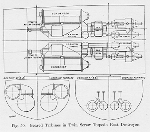 Gearing is also applicable to warships of the largest size (Fig. 51). It is also finding a place in cross-channel boats, and two such vessels for the South Western Railway Co. are being fitted with all geared turbines like the "Vespasian." The greatest material gain, however, will be found in extending the use of turbines to vessels of slow speed.
Half a century ago nearly all screw vessels had mechanical gearing, one element being composed of wooden teeth, because the screw revolved at too high a speed for the engines. Subsequently it was found practicable to increase the speed of the engines up to that of the screw, and gearing was consequently abandoned. Now very slow speed turbines are found to be incompatible with efficiency, and probably will always be so; accurately cut steel gearing comes to the rescue, and I think will be a permanent institution as long as steam is used to propel our ships.
Gearing is also applicable to warships of the largest size (Fig. 51). It is also finding a place in cross-channel boats, and two such vessels for the South Western Railway Co. are being fitted with all geared turbines like the "Vespasian." The greatest material gain, however, will be found in extending the use of turbines to vessels of slow speed.
Half a century ago nearly all screw vessels had mechanical gearing, one element being composed of wooden teeth, because the screw revolved at too high a speed for the engines. Subsequently it was found practicable to increase the speed of the engines up to that of the screw, and gearing was consequently abandoned. Now very slow speed turbines are found to be incompatible with efficiency, and probably will always be so; accurately cut steel gearing comes to the rescue, and I think will be a permanent institution as long as steam is used to propel our ships.
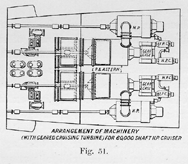
When we pass through the colliery or iron districts we often see clouds of steam blowing off to waste, but there is much less than was formerly the case, because low pressure turbines worked by the exhaust steam from other engines are coming into extended use for utilizing what was formerly a waste product. They are generally employed for the generation of electricity, or for working blast furnace blowers and centrifugal pumps and gas forcers, but recently an exhaust turbine of 750 horse-power has been applied to driving an iron plate mill in Scotland. It is especially interesting because it is the first turbine to be geared to a rolling mill. The turbine revolves at 2000 revolutions per minute, and by a double reduction of helical gears drives the mill at 70 revolutions. On the same shaft as the rolls is a flywheel of 100 tons weight which helps to equalize the speed. During the short time of each rolling the turbine and flywheel collectively exert 4000 horse-power, the maximum deceleration at the end of each roll being only 7 per cent.
So satisfactory has gearing proved up to the present that it seems probably that by its use turbines will be more widely adopted in the future for many purposes.
In conclusion, I would venture to predict that the use of the land and marine turbine will steadily increase, and that the improvements that are being made to still further increase its economy will for a long time enable the turbine to maintain its present leading position as a prime mover.
The Steam Turbine | Part II |